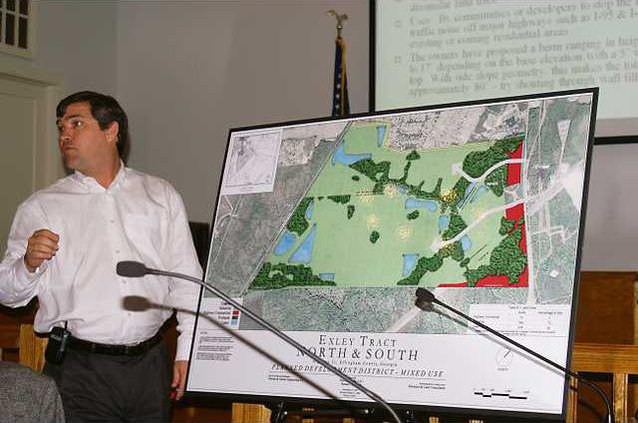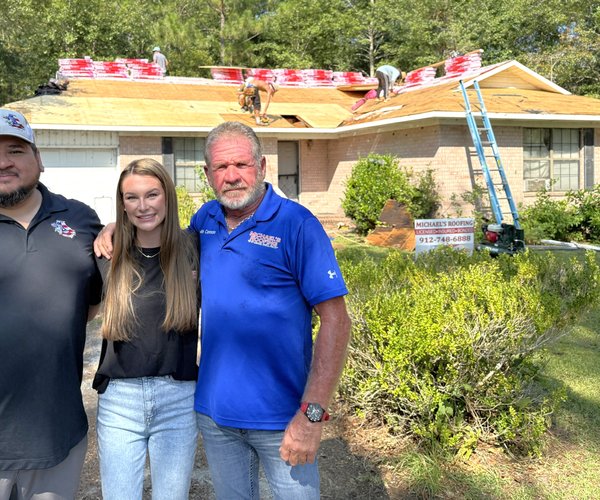Residents near a tract that is up for a controversial rezoning are hoping to get a little more time to go over statistics presented by that property’s owners.
Engineers and other representatives from the Exley tract and New Savannah group said Thursday night their findings showed the proposed rezoning from residential to industrial would not adversely affect air, water, soil and traffic.
“At the end of the day, that is all facts and figures,” said Carl Mirsky. “But they are still not taking into consideration the public’s opinion.
“I think the overall feeling is that people didn’t have enough time,” Mirsky said. “People moved here for the quality of life, and they want to build an industrial park in our backyard? How are we supposed to feel?”
County commissioners are scheduled to hold a public hearing on the matter at their meeting Tuesday. Commissioner Verna Phillips, in whose district the proposed rezoning lies, told the crowd of nearly 100 that she will recommend to her fellow commissioners to postpone the item at the request of the residents.
The rezoning request was tabled last month, and the developers have held two open meetings with residents to discuss their plans and their residents’ concerns.
“We agreed to table it ourselves to provide an opportunity to gather more information and provide more notification,” Rob Jones of Thomas and Hutton engineers said.
Owners of the property, which is about 1,043 acres, originally intended to put about 2,200 houses there. But the downturn in the housing market caused them to re-think their plans. At the last meeting, residents asked what the impacts on the soil, air, water and noise would be from rezoning the property to industrial.
“It’s an emotional issue. It’s an emotional issue on both sides,” said Chance Raehn of Thomas and Hutton. “We paid for these studies. You asked us to do it, so we did it. In some of our studies, we’ve learned our initial thought probably wasn’t the best idea.
“Not all the information put out against the rezoning has been correct. We have tried to address those issues here with both science and facts.”
While Exley and New Savannah property owners don’t have specific plans, they said their intention is to do something along the lines of Crossroads Business Park.
“This is a request for rezoning,” Raehn said. “We’re not here to apply for a development permit.”
He also said that any company that wishes to store chemicals at its site there would have to meet federal requirements. Any conditional use or variance would have to come before the commissioners.
“With a residential development, you don’t have to come before the commissioners to get a land disturbance permit,” he said. “We have to come back before the county every time for a land disturbing permit and a building permit.”
Plans call for a 150-foot buffer, including a berm, from the residential properties. Raehn said they will limit the height of the buildings to 37 feet nearest the property line, but many attendees questioned that, saying the original proposal was 35 feet.
The height of the buildings in the tract can be no greater than 55 feet, and Raehn said they would restrict those to well inside the property.
Raehn said their findings over the last two weeks showed there would be less traffic in and out of the property. By their count, the number of trips per day in and out of the property if it were rezoned industrial — 11,670 — would be half of those if it remained residential — 22,733.
“Traffic in warehouses is substantially less than typical development,” Jones said.
In monitoring air quality, engineers looked at three sites, most of them heavily traveled or industrial sites in Garden City near the port. Over an eight-year period, there were only seven days when the air quality exceeded Environmental Protection Agency guidelines and those came during very hot days.
They also compared air quality in the nearby neighborhood, the Exley tract, the CSX switchyard and in the Crossroads Business Park, using the first two as a baseline and the latter two as examples of what possibly could be in the tract in the future. With more diesel trucks than gasoline-burning cars coming through, the carbon monoxide levels would be lower if it were rezoned, Raehn said, and emissions at the tract are expected to be 1 percent of federal standards.
The Exley tract also is 10 to 20 feet lower than the neighboring residential property, so water runoff would drain into it.
Noise pollution studies were conducted at the four sites were air quality as sampled and on Interstates 16 and 95. Studies showed that the noise levels at Crossroads were within one decibel of those recorded in the neighborhood and the CSX switchyard levels were within seven decibels.
They also studied the berms at two residential developments — Savannah Quarters and Southbridge — that border the interstates. Savannah Quarters has a 20-foot berm and Southbridge has a 12-foot berm. Raehn said the noise differential based on the height of the berms was not significant.
“Increasing the height of a berm over 12 feet does not substantially reduce the noise level,” he said.
Developers are planning a 12-foot berm for most of the property line, going to 17 feet in some places. They also said they will plant wax myrtles, which grow fast, making the height of the vegetation 22 to 27 feet. Builders asking for the berms to be placed in the buffers.
In order to serve any proposed warehouses or manufacturing, developers want to bring in a rail spur off the CSX line that borders the property to the west. That spur likely will enter the middle of the property, but residents wondered about the noise of trains pulling in throughout the night.
Thomas and Hutton’s research also showed that industrial property brings a 13 times greater return on taxes than residential property since it doesn’t require the same level of services.
“Given the state of the housing market, it is not likely any activity would occur on this site for years,” Raehn said.
Residents also have questioned the notification process for the rezoning. Raehn said the owners followed the letter of the law in letting the neighboring residents know what their intentions were.
“It’s really a matter of law and county procedure,” he said. “It was not intended to run this under the radar. These two meetings are not required by the county process. We didn’t have to meet. We felt we needed to listen to cooperate.”
As a result, the county may take a look at its notification requirements. Currently, those mirror the state’s accepted guidelines.
Some residents also worried about the development as an example of a larger issue facing the county and its residents — where and how much development is right.
“They are still looking at this as a Goshen Hills issue and not an Effingham County issue,” Mirsky said.








